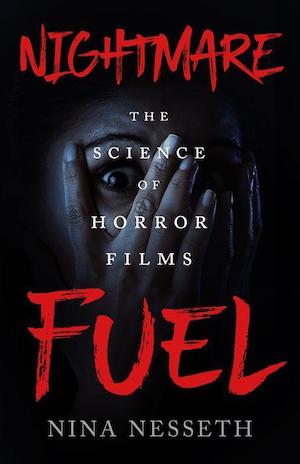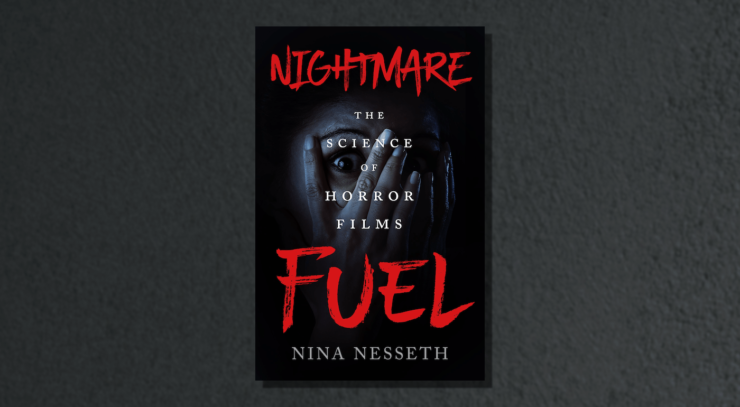Do you like scary movies? Have you ever wondered why?
We’re thrilled to share an excerpt from Nightmare Fuel: The Science of Horror Movies by Nina Nesseth, out from Nightfire on July 26th.
Nina Nesseth knows what scares you. She also knows why.
In Nightmare Fuel, Nesseth explores the strange and often unexpected science of fear through the lenses of psychology and physiology. How do horror films get under our skin? What about them keeps us up at night, even days later? And why do we keep coming back for more?
Horror films promise an experience: fear. From monsters that hide in plain sight to tension-building scores, every aspect of a horror film is crafted to make your skin crawl. But how exactly do filmmakers pull this off? The truth is, there’s more to it than just loud noises and creepy images.
With the affection of a true horror fan and the critical analysis of a scientist, Nesseth explains how audiences engage horror with both their brains and bodies, and teases apart the elements that make horror films tick. Nightmare Fuel covers everything from jump scares to creature features, serial killers to the undead, and the fears that stick around to those that fade over time.
With in-depth discussions and spotlight features of some of horror’s most popular films—from classics like The Exorcist to modern hits like Hereditary—and interviews with directors, film editors, composers, and horror academics, Nightmare Fuel is a deep dive into the science of fear, a celebration of the genre, and a survival guide for going to bed after the credits roll.
CHAPTER 1
THIS IS YOUR BRAIN ON HORROR
Nothing annoys me more than hearing people describe watching movies as a “brainless” activity—as if it involves somehow turning off your brain’s circuitry and relying solely on your eyeballs to coast through the movie’s run time. Plot twist: your brain is very much involved, engaged, and making the experience for you. Nothing makes this engagement more apparent than watching horror movies, where the filmmakers are crafting scares with your brain and body’s most likely reactions in mind.
Let’s start with a scene that appears in almost every horror flick ever made. Our protagonist is home alone at night, and the house is dark. They hear sounds they can’t explain, so they investigate. They go into a dark hallway and see a door at the end, slightly ajar. The room beyond is hidden by darkness. Is there something on the other side of the door? As the protagonist slowly makes their way forward, it’s so quiet that you can hear every breath and floorboard creak. The movie score is starting to creep up in volume. Your eyes scan every shadow and black corner of the hallway in case something might be hiding there, but it’s still too dark to be sure. We see something like apprehension on the protagonist’s face as they reach for the doorknob and jump back suddenly! to a musical sting as a cat streaks out of the room.
Buy the Book


Nightmare Fuel
Of course! It was the cat making those strange sounds—because cats are nocturnal weirdos that get bored and race around the house at night, knocking things off of shelves and doing whatever it is that cats do. The protagonist is relieved, laughing off their paranoia as they bend down to scoop up their pet. But in the next shot, they stand up, cat in their arms, and we see that a monster has appeared right behind them.
There’s a lot to unpack in this scene. The elements of fear, horror, and shock are all there, and are definitely being experienced by the character on-screen. When it comes to you as a moviegoer, your mileage may vary in terms of how much you experience each while you watch the scene play out.
When we look at what gives any good horror movie its true horror vibe, we end up with two distinct elements: terror and horror. We often use these terms interchangeably, but they are very different. Terror is where tension lives. It’s that awful, creepy-crawly feeling, the anxiety and anticipation that builds toward a horrifying event or realization—basically, it’s the heebie-jeebies. Horror is how we react once that event actually occurs. We can thank Ann Radcliffe, mother of Gothic literature, for those definitions.
To tweak Radcliffe’s vocabulary a little bit, I’m going to roll terror and all of the other pre-horror emotions into one and call it fear. We know fear. We experience fear all of the time as a mechanism to protect us from a Bad Thing that might happen.
Horror is the result of the Bad Thing happening.
It’s not surprising to know that fear is a useful tool. It keeps us alive. If you’re feeling fear in a dangerous situation, you’re more likely to problem-solve, try to put space between yourself and that situation, or be more cautious and avoid getting into that dangerous situation in the first place.
Fear is such a useful tool that some fears stick around for generations. A great example of an evolved fear is a common one: fear of the dark. Tool use and technology have created a world where humans have no natural predators, but if we turn the clocks far enough back on our history, we quickly find that we weren’t always at the top of the food chain. A theory for why humans are afraid of the dark stems from this history: many predators, like large wild cats, prefer to attack at nighttime. This also happens to be when human eyesight is at its worst. Fundamentally, we lack a shiny layer of tissue at the back of our eyeballs called the tapetum lucidum, which reflects light and allows for better night vision. It’s also why many animals have glowing eyes in photos taken with a flash, whereas humans are prone instead to “red eye,” thanks to light bouncing off of our blood vessel–rich retinas. Humans who were more fearful of the dark were more likely to stay somewhere safe during the night to avoid predation; whereas fearless humans might have been more likely to do something reckless, like venturing out at night with limited vision.
This fear may not be especially useful today, with our lack of predators and abundance of light, but it seems to have been conserved over generations. A small 2012 study performed by Colleen Carney at Ryerson University in Toronto subjected a group of good and poor sleepers to random bursts of white noise while they were either in a well-lit room or in the dark. In general, greater startle responses were recorded in the dark than in full light, and poor sleepers reported much more discomfort than their peers who have few problems snoozing. Discomfort is an important, if subjective, descriptor here: while it’s pretty common to hear people say that they’re afraid of the dark, it’s not typically a screaming sort of fear. What’s most commonly reported is a sense of uneasiness and foreboding when surrounded by darkness.
Filmmakers use this uneasy feeling to their advantage, often using dark color palettes and even darker corners to mask all sorts of ghouls, killers, demons, and other threats at the edges of the frame. If you’ve ever found yourself scanning the blackest parts of the screen for even a hint of something nefarious, it’s this evolved fear, coupled expertly with your basic understanding of horror movie tropes, at work.
The first thing to remember is that fear lives in your brain. We can experience more than one type of fear, and there is evidence for more than one kind of fear pathway in the brain. Many of them (but not all!) are grouped together in what’s known as the limbic system. There isn’t perfect consensus on which brain parts get to be included in the limbic system, but in general these areas are thought to be where the bulk of our emotions are processed.
Let’s go back to our horror protagonist, who’s just heard a strange noise. The limbic structures that we’re concerned with in this scenario include the amygdala, the hypothalamus, and the hippocampus.
The amygdala is an almond-shaped structure buried deep in each of the temporal lobes of your brain. The amygdalae are key to decoding many emotional responses, including the famed fight-or-flight response. It’s also linked to storing and processing fear-related information and fear memories. In 1994, researcher Ralph Adolphs and his team investigated disorders that caused lesions that affected the amygdala. What they found was that these people tended to have a tougher time recognizing and interpreting fearful expressions on other people’s faces. Interestingly, this same study found that the recognition of other emotions, like happiness, surprise, sadness, anger, and disgust, wasn’t affected. The amygdala is generally accepted as the primary brain center for fear processing, but even the amygdala might send signals along different circuits depending on whether the input is related to fear of pain, versus fear of a predator, versus fear of an attack by another human, and so on.
The hippocampus also plays a role in storing and retrieving memories, not to mention providing context to content. It is named for its shape, which looks like a seahorse’s curled-up tail (or, as I prefer to think of it, a jellyroll). The hippocampus and amygdala are the parts that will, consciously or unconsciously, compare the strange noise to memory and help our protagonist decide whether it might belong to a threat.
The hypothalamus is the link between your brain and your body’s hormones. It controls functions like thirst, appetite, fatigue, and more by producing signaling hormones that trigger other parts of the brain and body to release whatever other hormones are needed to suit a task—kind of like a hormonal relay system. The amygdala may be responsible for the famed fight-or-flight response, but it’s the hypothalamus that sends the signal to the amygdala that activates that response.
These three limbic structures aren’t the only parts of the brain in play in our protagonist’s scenario. As they make their way down the hallway, our protagonist tries to keep their fear in check before it gets the better of them. The ventrolateral prefrontal cortex (VLPFC) is your brain’s go-to region for willpower or self-control. Trying to get a handle on curbing your feelings of fear or some other emotion? The VLPFC will help you out by inhibiting other regions like the amygdala. Meanwhile, the ventromedial prefrontal cortex (vmPFC) is actively taking stock of how much control you have over a situation and helps shape your stress response.
When the cat jumps out and startles our protagonist, this new input bypasses the limbic system completely and goes straight to reflex mode. The brainstem is responsible here; it skips a lot of the processing work that happens in the crinkly folds of the cerebral cortex. It’s responsible for a lot of automatic functions that you really shouldn’t have to think about, like breathing or keeping your heart beating or reflexively protecting yourself from something jumping out at you.
And then, of course, our protagonist has a monster to contend with.
Excerpted from Nightmare Fuel: The Science of Horror Movies, copyright © 2022 by Nina Nesseth.










